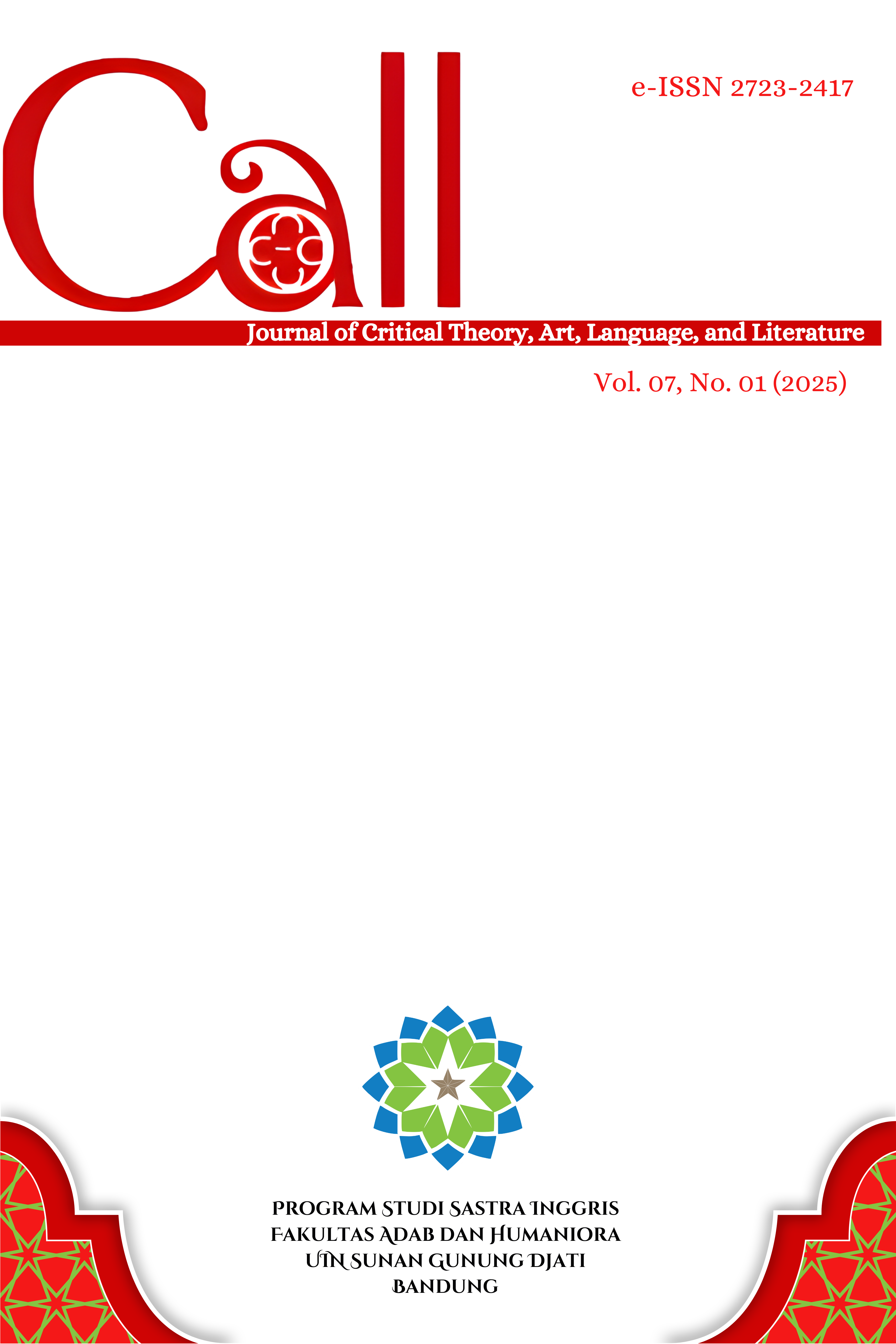Classroom Factors and Language Learning Anxiety: 2019-2024 Bibliometric Review
Main Article Content
Abstract
Article Details

This work is licensed under a Creative Commons Attribution-ShareAlike 4.0 International License.
Authors who publish in CALL agree to the following terms:
- Authors retain copyright and grant the journal right of first publication with the work simultaneously licensed under a Attribution-ShareAlike 4.0 International (CC BY-SA 4.0) License that allows others to share the work with an acknowledgment of the work's authorship and initial publication in this journal.
- Authors are able to enter into separate, additional contractual arrangements for the non-exclusive distribution of the journal's published version of the work (e.g., post it to an institutional repository or publish it in a book), with an acknowledgment of its initial publication in this journal.
- Authors are permitted and encouraged to post their work online (e.g., in institutional repositories or on their website) prior to and during the submission process, as it can lead to productive exchanges, as well as earlier and greater citation of published work (See The Effect of Open Access).
References
Alanazi, S., & Bensalem, E. (2024). Modeling the contribution of anxiety, enjoyment, and
classroom environment to boredom among students of English as a foreign language.
Vigo International Journal of Applied Linguistics, 21.
Alnuzaili, E. S., & Uddin, N. (2020). Dealing with anxiety in foreign language learning
classrooms. Journal of Language Teaching and Research, 11(2), 269–273.
DOI: http://dx.doi.org/10.17507/jltr.1102.15
Botes, E., van der Westhuizen, L., Dewaele, J.-M., MacIntyre, P. D., & Greiff, S. (2022).
Validating the Short-Form Foreign Language Classroom Anxiety Scale (S-FLCAS).
Applied Linguistics. https://doi.org/10.1093/applin/amac018
Diner, L. (2023). Anxiety in speaking Japanese experienced by the department of Japanese
language education students of Unnes. Journal of Japanese Language Education and
Linguistics, 7(2), 105–116. https://doi.org/10.18196/jjlel.v7i2.18737
Goshi, M. (2005). Foreign language classroom anxiety: How should the classroom teacher
deal with it? Journal of The School of Marine Science and Technology, 3(2), 61–66.
Hao, Z. A. (2024). The effect of the learning environment on students' anxiety and depression
levels. International Conference on Global Politics and Socio-Humanities, 94–101.
https://doi.org/10.54254/2753-7048/45/20230286
Horwitz, E. (2001). Language anxiety and achievement. Annual Review of Applied
Linguistics, 21. https://doi.org/10.1017/s026719050100007
Horwitz, E. K., Horwitz, M. B., & Cope, J. (1986). Foreign language classroom anxiety. The
Modern Language Journal, 70(2), 125. https://doi.org/10.2307/327317
Huang, Q. (2021). The role of English as a foreign language teachers’ and learners’ emotions
and language achievement and success. Frontiers in Psychology, 12, 756853.
https://doi.org/10.3389/fpsyg.2021.756853
Inagaki, R., & Nakaya, M. (2022). Relationship between Japanese language anxiety, beliefs
about Japanese learning, and Japanese language use in Japanese language classes.
European Journal of Educational Research, 11(3), 1327–1336.
https://doi.org/10.12973/eu-jer.11.3.1327
Issah Baako, & Abroampa, W. K. (2023). Research trends on ICT integration in education: A
bibliometric analysis. Cogent Education, 10(2), 2281162.
https://doi.org/10.1080/2331186X.2023.2281162
Jiang, Y. and Dewaele, Jean-Marc (2019) How unique is the foreign language classroom
enjoyment and anxiety of Chinese EFL learners? System 82 , pp. 13-25.
ISSN 0346-251X
Li, C., & Dewaele, J.-M. (2021). How classroom environment and general grit predict foreign
language classroom anxiety of Chinese EFL students. Journal for the Psychology of
Language Learning, 3(2), 86–98. https://doi.org/10.52598/jpll/3/2/6
Lin, H. C.-K., Chao, C.-J., & Huang, T.-C. (2015). From a perspective on foreign language
learning anxiety to develop an affective tutoring system. Educational Communications
and Technology, 727–747. https://doi.org/10.1007/s11423-0159385-6
Machida, T. (2010). Foreign language anxiety among intermediate-level university students
of Japanese. Annual Conference of the Central Association of Teachers of Japanese,
–75.
Mahir Pradana, Hanifah Putri Elisa & Syarifuddin Syarifuddin (2023) Discussing ChatGPT
in education: A literature review and bibliometric analysis, Cogent Education,
:2, 2243134, DOI: 10.1080/2331186X.2023.2243134
Nakao, S., & Reinders, H. (2022). “This is the end.†A case study of a Japanese learner’s
experience and regulation of anxiety. Education Sciences, 12(1), 25.
https://doi.org/10.3390/educsci12010025
Pawlak, M., Kruk, M., Zawodniak, J., & Pasikowski, S. (2020). Investigating factors
responsible for boredom in English classes: The case of advanced learners. System,
https://doi.org/10.1016/j.system.2020.102259
Purwaningrum, E. W., Hamamah, & Degeng, P. D. D. (2020). Japanese language learners’
anxiety: Barriers or successful support. Jurnal Budaya FIB UB, 1(1), 1–9.
Russell, V. (2020). Language anxiety and the online learner. Foreign Language Annals.
https://doi.org/10.1111/flan.12461
Sainee Tamphu, Imam Suyitno, Gatut Susanto, Nia Budiana, M. Rais Salim, Nurhikmah &
Wilda Purnawati (2024) Building bridges to the future of learning: Exploring artificial
intelligence research using R-Studio assisted bibliometrics, Cogent Education,
:1, 2417623, DOI: 10.1080/2331186X.2024.2417623
Toshiyuki Hasumi & Mei-Shiu Chiu (2024) Technology-enhanced language learning in
English language education: Performance analysis, core publications, and emerging
trends, Cogent Education, 11:1, 2346044, DOI: 10.1080/2331186X.2024.234604
Tsang, A. & Dewaele, J. (2024). The relationships between young FL learners’ classroom
emotions (anxiety, boredom, & enjoyment), engagement, and FL proficiency. Applied
Linguistics Review, 15(5), 2015-2034. https://doi.org/10.1515/applirev-2022-0077
Vusumuzi Maphosa & Mfowabo Maphosa (2023) African higher Education institution’s
response to COVID-19: A bibliometric analysis and visualisation study, Cogent
Education, 10:2, 2273002, DOI: 10.1080/2331186X.2023.2273002
White, C. J. (2018). The emotional turn in applied linguistics and TESOL: Significance,
challenges, and prospects. In Emotions in second language teaching (pp. 19–34).
https://doi.org/10.1007/978-3-319-75438-3_2
Yan Wang, & Kamarul Kabilan, M. (2024). Integrating technology into English learning in
higher education: A bibliometric analysis. Cogent Education, 11(1), 2404201.

